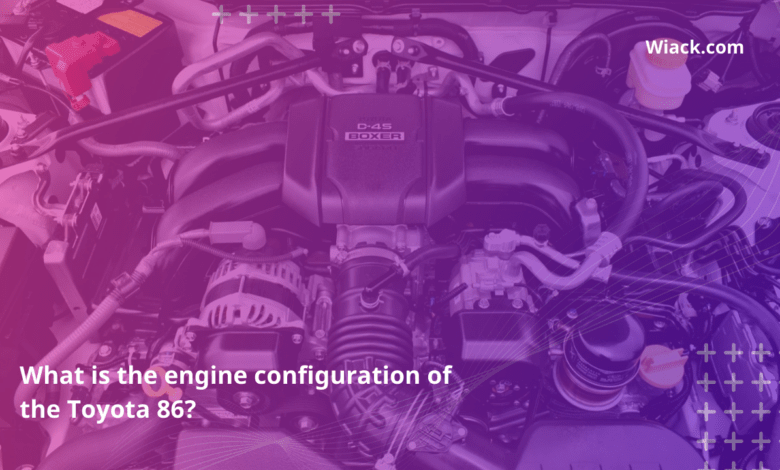What is the engine configuration of the Toyota 86?

Did you know that the Toyota 86 shares its engine with the Subaru BRZ, thanks to a unique collaboration between Toyota and Subaru? This partnership has resulted in a sports car that combines Toyota’s design expertise with Subaru’s renowned boxer engine technology, creating a vehicle that’s become a favorite among driving enthusiasts worldwide.
Engine Type
Horizontally Opposed Four-Cylinder (Boxer)
The heart of the Toyota 86 is its distinctive boxer engine. But what is the engine configuration of the Toyota 86 that makes it so special? The boxer engine, also known as a horizontally opposed engine, is a flat engine design where the pistons move horizontally, opposite to each other. This configuration is quite different from the more common inline or V-shaped engines found in most cars.
In the Toyota 86, this engine layout offers several advantages:
- Lower center of gravity: The flat design allows the engine to sit lower in the chassis, improving the car’s handling and stability.
- Balanced operation: The opposing piston movement naturally balances out many of the vibrations typically associated with engine operation.
- Compact design: The flat layout allows for a shorter engine bay, contributing to the 86’s sleek profile.
This engine configuration is a key factor in the Toyota 86’s reputation for excellent handling and driving dynamics. The low-mounted engine helps distribute weight evenly, giving the car its characteristic balanced feel during cornering and high-speed maneuvers.
Displacement
2.387 Liters
The current generation of the Toyota 86 features a 2.387-liter engine, often rounded to 2.4 liters in marketing materials. This displacement represents a significant increase from the previous generation’s 2.0-liter engine.
To put this into perspective:
- Previous generation (2012-2020): 1,998 cc (2.0 liters)
- Current generation (2021-present): 2,387 cc (2.4 liters)
This increase in displacement is one of the key factors contributing to the improved performance of the new Toyota 86. The larger engine size allows for more air and fuel to be combusted, resulting in increased power and torque.
It’s worth noting that despite the increase in engine size, the Toyota 86 maintains its lightweight and nimble character. This is achieved through careful engineering and the inherent advantages of the boxer engine configuration.
Valve Train
16-Valve DOHC (Double Overhead Camshaft)
The valve train is a crucial component of any engine, and the Toyota 86 doesn’t disappoint in this area. The engine features a 16-valve DOHC (Double Overhead Camshaft) system. But what does this mean for the average driver?
Let’s break it down:
- 16-valve: This means there are four valves per cylinder (two intake and two exhaust). More valves allow for better airflow in and out of the cylinders, which can improve engine efficiency and power output.
- DOHC (Double Overhead Camshaft): This system uses two camshafts per cylinder bank – one for the intake valves and one for the exhaust valves. The DOHC design allows for more precise control over valve timing and lift, which can result in improved performance across a wider range of engine speeds.
The 16-valve DOHC configuration in the Toyota 86 contributes to its high-revving nature and responsive character. It allows the engine to breathe efficiently at high RPMs, which is essential for a sports car designed to be driven enthusiastically.
Fuel System
Toyota D-4S Direct and Port Injection
One of the most innovative features of the Toyota 86’s engine is its D-4S fuel injection system. This system combines direct fuel injection with traditional port injection, offering the best of both worlds.
Here’s how it works:
- Direct Injection: Fuel is injected directly into the combustion chamber at high pressure. This allows for more precise fuel metering and can improve fuel efficiency and power output.
- Port Injection: Fuel is injected into the intake port, just before the intake valve. This method is particularly effective at lower engine speeds and can help keep the intake valves clean.
The D-4S system in the Toyota 86 can switch between or combine these two injection methods depending on the engine’s operating conditions. This results in optimal fuel delivery across all engine speeds and loads, contributing to the car’s smooth power delivery and efficiency.
Performance
Maximum Power
231 bhp (172 kW) @ 7,000 rpm
The current Toyota 86 boasts an impressive 231 bhp (172 kW) of power, peaking at 7,000 rpm. This high-revving nature is characteristic of naturally aspirated engines and contributes to the car’s exciting driving experience.
To put this into context:
- The previous generation Toyota 86 produced 205 bhp (153 kW)
- The current model represents a 12.7% increase in peak power
This increase in power is largely due to the larger engine displacement and refinements in the engine design. The high power peak at 7,000 rpm encourages drivers to explore the upper reaches of the rev range, which is part of what makes the Toyota 86 so engaging to drive.
Maximum Torque
250 Nm (184 lb-ft) @ 3,700 rpm
Torque is crucial for acceleration and overall drivability, and the Toyota 86 delivers 250 Nm (184 lb-ft) of torque, peaking at a relatively low 3,700 rpm. This represents a significant improvement over the previous generation:
- Previous generation: 205 Nm (151 lb-ft) @ 6,400-6,600 rpm
- Current generation: 250 Nm (184 lb-ft) @ 3,700 rpm
The increase in torque and its availability at lower rpm means the new Toyota 86 feels more responsive in everyday driving situations, addressing one of the main criticisms of the previous model.
Transmission Options
The Toyota 86 offers two transmission options, catering to different driver preferences:
6-Speed Manual
The 6-speed manual transmission is a favorite among enthusiasts. It offers:
- Direct, engaging driving experience
- Short, precise shift throws
- Better control over gear selection for performance driving
6-Speed Automatic
For those who prefer an automatic, the Toyota 86 offers a 6-speed automatic transmission with paddle shifters. This option provides:
- Convenience in daily driving
- Paddle shifters for manual control when desired
- Sport mode for more aggressive shift patterns
Both transmissions are well-matched to the engine’s characteristics, offering smooth operation and quick shifts to make the most of the engine’s power band.
Drive Type
Rear-Wheel Drive
The Toyota 86 is a rear-wheel drive (RWD) car, a configuration that’s becoming increasingly rare in modern sports cars, especially at this price point. RWD offers several advantages:
- Better weight distribution: With the engine in the front and drive going to the rear wheels, weight is more evenly distributed across the car.
- Improved handling: RWD allows for better cornering dynamics and more predictable behavior at the limit.
- Potential for oversteer: This can make the car more engaging for experienced drivers, allowing for techniques like controlled drifting.
The RWD configuration, combined with the low center of gravity provided by the boxer engine, is a key factor in the Toyota 86’s reputation for excellent handling and driving dynamics.
Engine Code
FA24
The engine in the current Toyota 86 is known by the code FA24. This designation provides some important information:
- FA: This denotes the engine family, which is shared with several Subaru models.
- 24: This indicates the approximate displacement (2.4 liters).
The FA24 is an evolution of the FA20 engine used in the previous generation Toyota 86. It maintains the same basic architecture but with increased displacement and numerous refinements to improve power, torque, and overall performance.
Notable Features
Naturally Aspirated
Unlike many modern sports cars that use turbocharging to boost power, the Toyota 86 remains naturally aspirated. This design choice offers several benefits:
- Linear power delivery: Power builds progressively as engine speed increases, providing a more predictable and engaging driving experience.
- Immediate throttle response: Without turbo lag, the engine responds instantly to throttle inputs.
- Simplicity and reliability: Naturally aspirated engines generally have fewer components than turbocharged engines, potentially leading to improved long-term reliability.
High Revving
The Toyota 86’s engine is designed to rev freely, with peak power arriving at 7,000 rpm. This high-revving nature:
- Encourages an engaging driving style
- Provides a thrilling auditory experience
- Allows for a wide powerband, giving drivers more flexibility in gear selection
Lightweight Design
Despite the increase in displacement, the FA24 engine maintains a lightweight design. This is crucial for the Toyota 86’s overall performance and handling characteristics. The lightweight engine contributes to:
- Better weight distribution
- Improved agility and responsiveness
- Enhanced fuel efficiency
Comparison to Previous Generations
2013-2020 Toyota 86 (FA20 Engine)
To fully appreciate the advancements in the current Toyota 86, it’s worth comparing it to its predecessor:
2.0-liter Boxer Engine
The previous generation used a smaller 2.0-liter boxer engine, known as the FA20. This engine was praised for its high-revving nature but criticized for its lack of low-end torque.
205 bhp (153 kW) @ 7,000 rpm
The FA20 engine produced 205 bhp in manual transmission models (200 bhp with the automatic). While this was adequate, many enthusiasts felt the car could benefit from more power.
205 Nm (151 lb-ft) @ 6,400-6,600 rpm
Perhaps the biggest criticism of the FA20 engine was its lack of low-end torque. With peak torque arriving at a high 6,400-6,600 rpm, the car could feel underpowered in everyday driving situations.
The current FA24 engine addresses many of these criticisms, offering more power and significantly more torque at lower rpm, while maintaining the high-revving character that made the original Toyota 86 so engaging to drive.
Conclusion
Summary of Engine Configuration
The Toyota 86 features a 2.4-liter horizontally opposed four-cylinder (boxer) engine, known as the FA24. This naturally aspirated engine produces 231 bhp and 250 Nm of torque, sent to the rear wheels through either a 6-speed manual or 6-speed automatic transmission.
Key features of the engine include:
- 16-valve DOHC valve train
- Toyota D-4S direct and port injection system
- High-revving design with peak power at 7,000 rpm
- Increased torque available at lower rpm compared to the previous generation
Importance of Engine in Performance and Handling
The engine configuration of the Toyota 86 is crucial to its character and performance. The boxer layout allows for a low center of gravity, improving handling and stability. The naturally aspirated design provides linear power delivery and immediate throttle response, enhancing the car’s engaging driving experience.
The increase in displacement and refinements made to the FA24 engine have addressed many of the criticisms of the previous model, resulting in a more powerful and flexible powerplant that maintains the high-revving character enthusiasts love.
In conclusion, the engine configuration of the Toyota 86 is a key factor in its appeal to driving enthusiasts. It combines the unique characteristics of a boxer engine with Toyota’s advanced D-4S injection system and a high-revving naturally aspirated design. This combination results in a sports car that offers an engaging driving experience, balanced handling, and improved performance over its predecessor, all while maintaining the lightweight and affordable nature that has made the Toyota 86 a favorite among car enthusiasts worldwide.
Get the latest car news, reviews, and prices at Wiack.com. Your one-stop destination for all things automotive.





